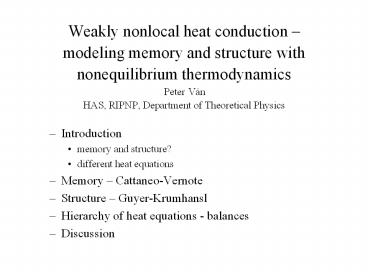Weakly nonlocal heat conduction - PowerPoint PPT Presentation
Title:
Weakly nonlocal heat conduction
Description:
Weakly nonlocal heat conduction. modeling memory and structure with ... Jou, D. , Casas-V zquez, J. and Lebon, G., Extended Irreversible Thermodynamics, ... – PowerPoint PPT presentation
Number of Views:28
Avg rating:3.0/5.0
Title: Weakly nonlocal heat conduction
1
Weakly nonlocal heat conduction modeling
memory and structure with nonequilibrium
thermodynamics Peter Ván HAS, RIPNP,
Department of Theoretical Physics
- Introduction
- memory and structure?
- different heat equations
- Memory Cattaneo-Vernote
- Structure Guyer-Krumhansl
- Hierarchy of heat equations - balances
- Discussion
2
Why nonequilibrium thermodynamics?
- Thermodynamics
science of temperature
Thermodynamics science of macroscopic
energy changes
general framework of any Thermodynamics
(?) macroscopic (?) continuum (?)
theories
- General framework
- Second Law
- fundamental balances
- objectivity - frame indifference
reversibility special limit
3
Nonlocalities
Restrictions from the Second Law. change of the
entropy current change of the entropy
Change of the constitutive space
4
Weakly nonlocal memory inertia
5
(No Transcript)
6
Non-homogeneous equilibrium structure
s
a
Single well
7
s
a
Double well two phases
8
Stable mixed sructure twinning in shape memory
alloys Initial and boundary conditions!
9
Second Law
basic balances
- basic state
- constitutive state
- constitutive functions
Second law
(universality)
Constitutive theory
Method Liu procedure - solving the Liu
equations
10
Ginzburg-Landau (thermodynamic, relocalized)
constitutive state space
constitutive functions
local state
Liu procedure (Farkass lemma)
?
11
Basic state, constitutive state and constitutive
functions
Heat conduction Extended Thermodynamics
- basic state
- constitutive state
- constitutive functions
Heat conduction
Fourier
Cattaneo-Vernote
Guyer-Krumhansl
12
Weakly nonlocal extended thermodynamics
state space
constitutive space
constitutive functions
local state
Liu procedure (Farkass lemma)
It is not solvable! Currents and forces?
solution?
13
extended (Gyarmati) entropy
concave entropy (stability)
entropy current (Nyíri) (B current multiplier)
plausible general (dETdS qTJ)
14
Solution, conditions (e.g. L11 p.d.)
gradients
Guyer-Krumhansl equation new
terms applications? Liu?
15
Weakly nonlocal extended thermodynamics (again)
state space
constitutive space
constitutive functions
Specific questions
Why?
balance form
Why?
locality
Closure?
hierarchy
16
Weakly nonlocal extended thermodynamics (again)
state space
constitutive space
constitutive functions
First order nonlocality
Liu procedure (Farkass lemma)
Liu equations
17
Lius theorem
Conditions
Usage
Consequences
18
Balance form evolution local s, H
Liu equations
Dissipation inequality
19
New independent variables! potential
structure no dissipation
20
Weakly nonlocal extended thermodynamics (again)
state space
constitutive space
constitutive functions
Second order nonlocality local state s(e,q)
Liu procedure (Farkass lemma)
Liu equations
21
Once more
extended entropy
current multiplier
Closed (trivial)
Almost balance
22
- Discussion
- Kinetic phenomenological
- Universality independent on the micro-modell
- Constructivity Liu force-current systems
- Origin of balances?
- Closure
- C(weakly nonlocal in time)?
- Second Law
23
References General Gyarmati, I., The wave
approach of thermodynamics and some problems of
non-linear theories, Journal of Non-Equilibrium
Thermodynamics, 1977, 2, p233-260. Müller, I.
and Ruggeri, T. Rational Extended
Thermodynamics, Springer Verlag, 1998, Springer
Tracts in Natural Philosophy V 37, New
York-etc. Jou, D. , Casas-Vázquez, J. and Lebon,
G., Extended Irreversible Thermodynamics,
Springer Verlag, 2001, Berlin-etc., 3rd, revised
edition. Heat conduction Cimmelli, V. A. and
Ván, P., The effects of nonlocality on the
evolution of higher order fluxes in
non-equilibrium thermodynamics, Journal of
Mathematical Physics, 2005, 46, p112901,
(cond-mat/0409254). Ciancio, V. , Cimmelli, V.
A. and Ván, P., On the evolution of higher order
fluxes in non-equilibrium thermodynamics, 2006,
(cond-mat/0407530).
24
Thank you for your attention!































